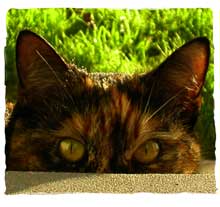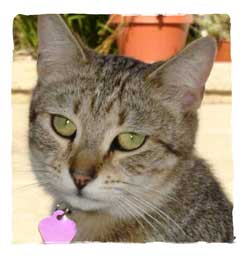Put on your thinking caps, katz’n’kittenz. Here comes a word problem!
[UPDATE: My solution appears in the comments below.]
Molly the Cat and Tigger live here in our house. They each came to live with us at different times, and of their own choosing. Those could be long stories, one of which I’ve already told here, so I’ll skip ahead to the math problem.


No sooner had they moved in than they started asking for food. Regular meals, and they were quite insistent about it. Being the good ex-hippies that we are, we took it upon ourselves to provide not just a tasty menu, but also excellent nutrition. It took a while, but we finally found a brand of canned food that they liked and that we thought was good for them, and no less than three brands of dry food (hereafter called “crunchies”).
Tigger is a boy, and a little bigger than Molly, and over time we figured out that he needed more food than Molly. No doubt he thought we were hopelessly stupid during the months it took us to come to this realization, but eventually we did, and here is how the daily diet eventually took shape: Breakfast is at 7:00 AM and dinner (“supper” to you Eastern seaboarders) is at 6:00 PM. At each seating, Molly gets one fifth of a can and Tigger gets one fourth of a can. Throughout the day and in the evenings both of them get all the crunchies they want. To make it easier to measure the fractions of cans, each critter eats only from his or her own can until it is empty, then moves on to the next can in the cupboard. So it takes four meals (or two days) for Tigger to empty his can, and five meals (or two and a half days) for Molly to do the same.
You wouldn’t think that both cans would be empty at the same time very often, would you? You’d be right. But for a long time I have had the feeling that that event (two cans empty at the same time — two fresh cans opened for the same meal) was happening a little too often. For about a year, I had that feeling. Somebody — either me or Mrs. Jones — was screwing up the measurements at feeding time. To be fair, it’s pretty hard to eyeball a fifth of a can, and both of us may have muffed it from time to time.
Last night we figured out exactly how often this should happen. I’m embarrassed to say that it took two college graduates a half hour to come up with the definitive answer, and even now we don’t understand it mathematically. How fast can you solve the problem?
Start with two full cans. Give Molly a fifth of her can at each meal, and Tigger a fourth of his can at each meal. Put plastic caps on them and refrigerate between meals. Whenever a can is empty, open a new one. How many days before you find yourself opening two new cans at the same time?
Go ahead and tell me the answer in the comments, if you can. We figured it out basically by running a model scenario all the way to the end, but there is also a mathematical formula that is much more elegant and sophisticated. Except I can’t figure it out and explain the “why” of it. So help me with that, too.
My answer will be posted soon.


Every 20 feedings?
kStyle – Is that a question or an answer? Also, please show your work! How did you arrive at your solution?
100% percent of you (kStyle) came up with the correct answer! Yay for you!
I’m terrible at math, but I knew instinctively that the correct solution was going to be 4×5=20, meaning 20 feedings, or five days, but I had no idea why it should be so, and I was hoping someone would explain it to me. I probably still wouldn’t have understood it mathematically, but I would like to think that somebody knows how to do this stuff.
Mrs. Jones and I sat in the kitchen and discussed it for quite a while, purely theoretically, before we finally devised a way to be sure of the answer. What we did was we got four quarters (to represent Tigger’s servings) and five nickels (for Molly’s), and lined them up on the kitchen table. Then we took coins away from Tigger’s pile and from Molly’s, noting each coin removal as a meal. When one cat’s pile of coins was gone, we replaced the whole pile and kept going (and counting each “meal”) until — after 20 meals — it came out even.
Now we know for sure that we are screwing up the measurements, because things are coming out even with the real cat food a lot more often than that.
I’d have noticed the food-can-emtying-time discrepancy but I’d never have figured out a way to explain why it was happening. This is because I hated word problems in math as a child. When presented with a word problem my first impulse would be to go to sleep. The second would be to say, “who cares?” I’d still have to DO the word problem, but I always got them wrong.
In the end, if Molly and Tigger were mine, I would have figured Molly was just enjoying a little extra now and then, and as long as she wasn’t getting obese, why worry? ;o)
Wren – Actually, I liked word problems in school. But in those days I could occasionally solve them. These days, I can’t. And the coin method definitely would have earned me an “F” in my school days. You’re supposed to reduce the problem to an equation, then solve the equation. The coin thing is like counting on your fingers, out loud.
Anybody?
I can explain! I can!
You need to find the least common multiple of 4 and 5, or the smallest number that you can divide by both four and five.
Four and five lack any helpful common factors. In other words, they are not divisible by any of the same numbers except 1.
The factors of 4 are: 1, 2, and 4
The factors of 5 are: 1, 5
Therefore, the least common multiple will be 4 x 5 = 20.
This would be more complicated with numbers like 6 and 9, because they share 3 as a common factor…
factors of 6: 1, 2, 3, 6
factors of 9: 1, 3, 9
Then I wouldn’t know how to solve it anymore.
Check it: http://www.math.com/school/subject1/lessons/S1U3L3GL.html
(Feel free to edit this to make the link more linky; the link button was not working for me.)
[Editor’s note: Here’s the link, made more linky.]
Tomorrow we will compare and contrast photosynthesis and respiration.
kStyle – Or should I say “EinStyle?” Thanks for the explication. As predicted, I don’t know what you’re talking about, but I’m glad you do. I think I’ll do better tomorrow, with life sciences, …
I had a few gigs substitute teaching for middle school math teachers last school year.
PS Did you refer to the linky-link? I thought it explained it well.